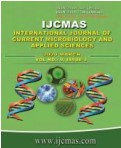


 National Academy of Agricultural Sciences (NAAS)
National Academy of Agricultural Sciences (NAAS)

|
PRINT ISSN : 2319-7692
Online ISSN : 2319-7706 Issues : 12 per year Publisher : Excellent Publishers Email : editorijcmas@gmail.com / submit@ijcmas.com Editor-in-chief: Dr.M.Prakash Index Copernicus ICV 2018: 95.39 NAAS RATING 2020: 5.38 |
Water hyacinth (Eichhornia crassipes) is one of the most troublesome weed in the aquatic systems. It causes severe environmental and economical problems in many tropical and subtropical parts of the world. Studies were conducted on assessment of new ecotechnological measures to restore the eutrophicated lake from noxious aquatic weed. The first phase of the experiment was conducted by composting the water hyacinth biomass with crop residues. Analytical results of the composting study revealed that T5 (Water Hyacinth + Crop Residue + Cow dung (1:1:1) + Pleurotus+ Eudrilus euginae) had the higher total nitrogen value of 0.93%, total phosphorous 1% and total potassium 1.10%. The phytotoxicity studies showed that T5, recorded maximum germination percentage (100%) and greater vigour index compared to other treatments. The second phase of the experiment was, native microorganisms isolated from the water samples of the eutrophicated lake was identified as Xanthomonas sp., Pseudomonas fluorescens, Enterobacter sp., and Bacillus sp. were mass multiplied and used for pollution degradation. The best culture for pollution reduction was observed to be EL3 (P. fluorescens). It has recorded 75.19% reduction of total nitrogen, 88.05% reduction of total phosphorous and 100% reduction in heavy metals. Hence, the potential of this organism may be utilised through biostimulation and bioaugmentation process to restore the eutrophicated lake.
 |
 |
 |
 |
 |